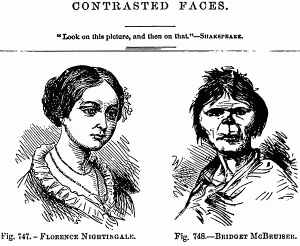Is race a biological or social construct?
The word “race” as it is applied to describing ancestral traits in humans is notoriously difficult to disambiguate. The word itself is polysemous, or has different but related senses depending on the context of the discussion. The word “man” is also a polyseme that is ambiguous to the point that its use can obscure meaning. Man can be used in the sense of the words humanity, males, or the human genus.
In any discussion of race, the word can change senses even during the same discussion. Depending on context, the word “race” may refer to groups or populations of humans categorized together by culture, ethnicity, genetics, geography, language, anatomy, nationality, lineages, subspecies, or social groups. Moreover at different times in history, race had different senses complicating things even more.
Sometimes the confusion between senses is intentional because race has been used throughout history by one group to dehumanize another group. Racism has inspired atrocities like the Holocaust that have left an ugly scar on human history. An association with Nazism is so repellent that it has become the king of all hyperbolic fallacies to tar an opponent with. It is often indicative of a lack of evidence for an argument.
Is Evolution Racist?
Ken Ham, biblical literalist of the group Answers in Genesis, in his book The New Answers, confounds different senses of race from distinctly different time periods in an effort to paint Charles Darwin’s Theory of Evolution as racist and responsible for evil acts associated with racism:
In the 1800s, before Darwinian evolution was popularized, most people, when talking about “races,” would be referring to such groups as the “English race,” “Irish race,” and so on. However, this all changed in after the works of Charles Darwin starting with On The Origin of Species by Means of Natural Selection or the Preservation of Favoured Races in the Struggle for Life.
It is important at this point to note the sense that Darwin is using “Favoured Races” in the title. The word for him in a scientific sense meant varieties.
In context from the book Ham is quoting, Darwin uses races to refer to cabbages:
“the several races, for instance, of the cabbage.”

Ham goes on from the mere title of the book to attribute to Darwin something he never meant, as human origins are not discussed in Origins of Species:
Darwinian evolution was (and still is) inherently a racist philosophy, teaching that different groups or “races” of people evolved at different times and rates, so some groups are more like their apelike ancestors than others.
Putting aside for second that even Ham agrees with scientific findings that there are no distinct human races. Darwin in The Descent of Man, and Selection in Relation to Sex actually said:
It may be doubted whether any character can be named, which is distinctive of a race and is constant … they graduate into each other, and … it is hardly possible to discover clear, distinctive characters between them … As it is improbable that the numerous, and unimportant, points of resemblance, between the several races of man, in bodily structure and mental faculties (I do not here refer to similar customs) should all have been independently acquired, they must have been inherited from progenitors who had these same characters.
So long before there was a scientific consensus that the human species does not have distinct scientific races, Darwin doubted whether there was any “character which is distinctive of a race” that could be named. He considered the “points of resemblance” to be unimportant in distinguishing one “race” from another.
For someone of Darwin’s era wrestling with cultural prejudices of his day to admit that superficial differences and resemblances did not distinguish one race from another shows he had a progressive viewpoint. During his famous voyage on The Beagle, he lamented the treatment of Aborigines and other groups and vowed to never visit a slave country for that reason.
Not that Ken Ham is the final word on the scientific basis of race. However, his unfounded accusations that Darwin and Evolution are responsible for the racism that followed even today is a good example of playing on the different senses of the word “race” to score political points. He concludes:
As a result of Darwinian evolution, many people started thinking in terms of the different people groups around the world representing different “races,” but within the context of evolutionary philosophy. This has resulted in many people today, consciously or unconsciously, having ingrained prejudices against certain other groups of people.
The rise of “Scientific Racism”
Nice try, Ken Ham! Although after Darwin there was a period in history where people tried to justify their racial supremacy with science, racism predates Darwin’s use of the word “race” in a book title. A good example of this comes from the period in the 19th century of “scientific racism” following Darwin. Although the reasoning of that period produced no conclusive results of racial superiority that anyone could replicate. Science just didn’t support their claims about races.
According to Nell Irvin Painter’s book The History of White People, in the beginning of the 19th century Anglo/Saxon Whites considered themselves superior to “Celtic” Whites. (Modern DNA analysis established that the Irish are not descendants of the savage Keltoi) Hence the Irish race designation that Ham referred to that was a different sense of the word race than Darwin used. They even used pseudoscientific studies of anatomy to justify their centuries old prejudices toward Irish Catholics. This picture is an example:

Notice the apelike features of “Bridget McBruiser”, it was proposed that the Irish migrated from Africa and that they had “apelike” features. Claims like these are the true origin of Ham’s assertion that people believed some races were more apelike than others –not Darwin. These same anatomical observations were used to justify slavery of Africans. People retrofitted their own preexisting cultural biases and prejudices with pseudoscientific theories. Sort of like how the creationist worldview predated modern science and attempts to co-opt its findings to support their a priori conclusions.
During the 19th century and what was called “scientific racism”, people sought to justify prejudices using race in a taxonomic sense and attempted to classify different races by phenotype alone. There was a mistaken belief even among scholars called polygenism that posited humans shared no common ancestor and evolved separately on different continents. Darwin predicted that there would be no physical characteristics that distinguished one race from another. This idea was soon after famously endorsed by Franz Boaz.
Until the late 19th century, the sense of the word race for scientific research settled on investigating if “race” had the rank of subspecies specifically in humans. Subspecies has a very solid sense as it is a scientific word. An example of subspecies is the domestic dog being a subspecies of an Asiatic wolf species.
Is race a cline?
There was also a discredited explanation that race was describing the biological phenomena known as a cline. A cline is a genetic feature that diffuses through a biological community in a gradient pattern. For example, melanin the molecule responsible for skin tone decreases in a gradient pattern the further the distance North or South from the equator. Skin color has played havoc with people’s perceptions of how supposedly different one group of humans is from another, thousands of years before Darwin. The distribution of melanin would match the proposed model that race describes a cline in the human gene pool.
However, in 1964, the biologists Paul Ehrlich and Holm pointed out the blood type beta-S hemoglobin rather than radiating out of Africa in a gradient pattern, actually radiates from specific geographical points in Africa. Many people have heard of the model that Homo sapiens migrated out of Africa between 125,000 to 60,000 years ago. Had there been only one migration, the patterns of distribution of blood types may have matched the gradient pattern we see with melanin distribution.
Is there enough differences between human races to designate subspecies?
Because the patterns are discordant, the only scientific basis that could distinguish one “race” from another is if race matched the scientific rank of subspecies. Unlike wolves compared to dogs, and our close cousins the chimpanzees that have a subspecies called Bonobos, Homo sapiens have more genetic differences in their native populations than they do from each other at the species level. One hundred percent of our genetic diversity can be found in a single population in Africa compared to seventy percent found in a population from New Guinea. What this points to more than anything is multiple migrations from Africa that have prevented the amount of genetic drift required for speciation or even sub-speciation from occurring.
Is race biologically significant?
Many of the characteristics we think of as racial like skin tone are more like what Darwin originally thought of as variation within the same species in response to environmental pressures. These superficial differences so remarked on by people justifying their group’s own superiority are from a scientific point of view unimportant. These scientific observations neatly answer the original question of whether race is a biological or social construct. People may commonly believe that there are three or five or however many races, but scientists beginning with Darwin disagree, as this cannot be demonstrated. Thus strict racial divisions have no basis in science. Nor do the racist ideas that people have used to divide social groups into classes, and justify their own supposed superiority. The only real basis for racial divisions that still disadvantage millions of people is social.
*Revised edition of what I published in Secular Nation in March 2015.